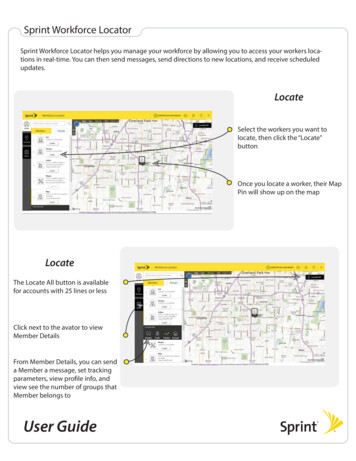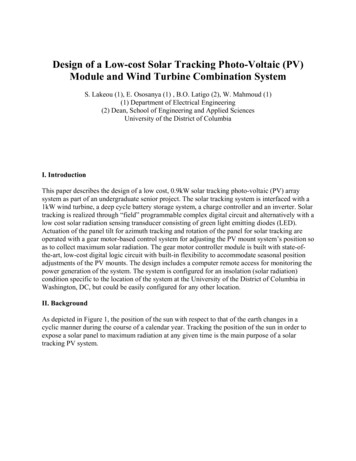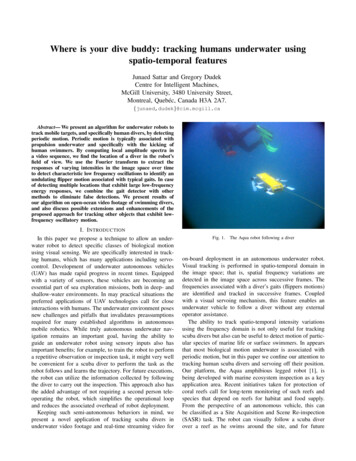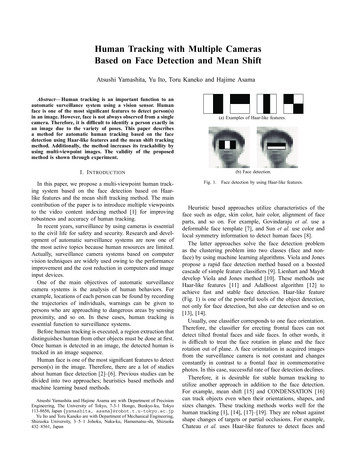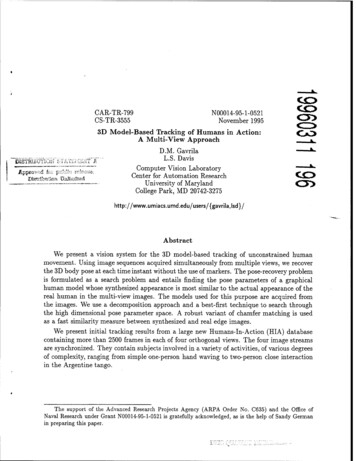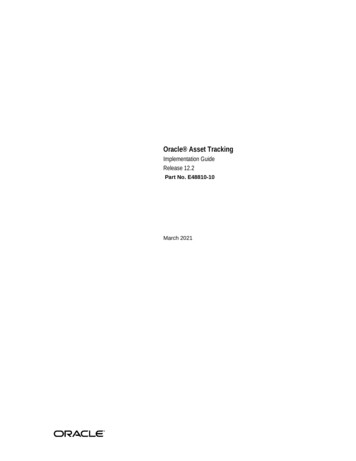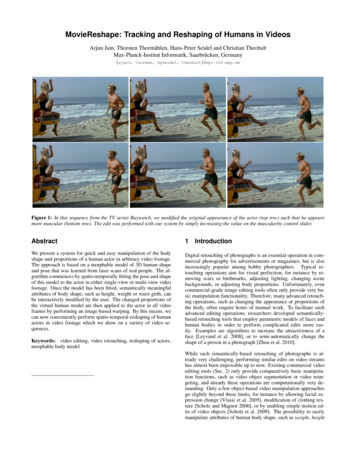
Transcription
MovieReshape: Tracking and Reshaping of Humans in VideosArjun Jain, Thorsten Thormählen, Hans-Peter Seidel and Christian TheobaltMax-Planck-Institut Informatik, Saarbrücken, Germany{ajain, thormae, hpseidel, theobalt}@mpi-inf.mpg.deFigure 1: In this sequence from the TV series Baywatch, we modified the original appearance of the actor (top row) such that he appearsmore muscular (bottom row). The edit was performed with our system by simply increasing the value on the muscularity control slider.Abstract1We present a system for quick and easy manipulation of the bodyshape and proportions of a human actor in arbitrary video footage.The approach is based on a morphable model of 3D human shapeand pose that was learned from laser scans of real people. The algorithm commences by spatio-temporally fitting the pose and shapeof this model to the actor in either single-view or multi-view videofootage. Once the model has been fitted, semantically meaningfulattributes of body shape, such as height, weight or waist girth, canbe interactively modified by the user. The changed proportions ofthe virtual human model are then applied to the actor in all videoframes by performing an image-based warping. By this means, wecan now conveniently perform spatio-temporal reshaping of humanactors in video footage which we show on a variety of video sequences.Digital retouching of photographs is an essential operation in commercial photography for advertisements or magazines, but is alsoincreasingly popular among hobby photographers. Typical retouching operations aim for visual perfection, for instance by removing scars or birthmarks, adjusting lighting, changing scenebackgrounds, or adjusting body proportions. Unfortunately, evencommercial-grade image editing tools often only provide very basic manipulation functionality. Therefore, many advanced retouching operations, such as changing the appearance or proportions ofthe body, often require hours of manual work. To facilitate suchadvanced editing operations, researchers developed semanticallybased retouching tools that employ parametric models of faces andhuman bodies in order to perform complicated edits more easily. Examples are algorithms to increase the attractiveness of aface [Leyvand et al. 2008], or to semi-automatically change theshape of a person in a photograph [Zhou et al. 2010].Keywords: video editing, video retouching, reshaping of actors,morphable body modelIntroductionWhile such semantically-based retouching of photographs is already very challenging, performing similar edits on video streamshas almost been impossible up to now. Existing commercial videoediting tools (Sec. 2) only provide comparatively basic manipulation functions, such as video object segmentation or video retargeting, and already these operations are computationally very demanding. Only a few object-based video manipulation approachesgo slightly beyond these limits, for instance by allowing facial expression change [Vlasic et al. 2005], modification of clothing texture [Scholz and Magnor 2006], or by enabling simple motion edits of video objects [Scholz et al. 2009]. The possibility to easilymanipulate attributes of human body shape, such as weight, height
or muscularity, would have many immediate applications in movieand video post-production. Unfortunately, even with the mostadvanced object-based video manipulation tools, such retouchingwould take even skilled video professionals several hours of work.The primary challenge is that body shape manipulation, even in asingle video frame, has to be performed in a holistic way. Since theappearance of the entire body is strongly correlated, body reshapingsolely based on local operations is very hard. As an additional difficulty, body reshaping in video has to be done in a spatio-temporallycoherent manner.We therefore propose in this paper one of the first systems in the literature to easily perform holistic manipulation of body attributes ofhuman actors in video. Our algorithm is based on a 3D morphablemodel of human shape and pose that has been learned from fullbody laser scans of real individuals. This model comprises a skeleton and a surface mesh. Pose variation of the model is describedvia a standard surface skinning approach. The variation of the bodyshape across age, gender and personal constitution is modeled ina low-dimensional principal-component-analysis (PCA) parameterspace. A regression scheme enables us to map the PCA parametersof human shape onto semantically meaningful scalar attributes thatcan be modified by the user, such as: height, waist girth, breastgirth, muscularity, etc. In a first step, a marker-less motion estimation approach spatio-temporally optimizes both the pose andthe shape parameters of the model to fit the actor in each videoframe. In difficult poses, the user can support the algorithm withmanual constraint placement. Once the 3D model is tracked, theuser can interactively modify its shape attributes. By means of animage-based warping approach, the modified shape parameters ofthe model are applied to the actor in each video frame in a spatiotemporally coherent fashion.We illustrate the usefulness of our approach on single-view andmulti-view video sequences. For instance, we can quickly and easilyalter the appearance of actors in existing movie and video footage.Further on, we can alter the physical attributes of actors capturedin a controlled multi-view video studio. This allows us to carefullyplan desired camera viewpoints for proper compositing with a virtual background, while giving us the ability to arbitrarily retouchthe shape of the actor during post-processing. We also confirmedthe high visual fidelity of our results in a user study.2Previous WorkIn our work we can capitalize on previous research from a varietyof areas. Exemplary work from the most important areas is brieflyreviewed in the following.Several commercial-grade image manipulation tools exist1 that enable a variety of basic retouching operations,such as segmentation, local shape editing, or compositing. The research community also worked on object-based manipulation approaches that broaden the scope of the above basic tools, e.g., [Barrett and Cheney 2002]. Unfortunately, more advanced image editsare very cumbersome with the aforementioned approaches. A solution is offered by semantically-guided image operations, in whichsome form of scene model represents and constrains the space ofpermitted edits, such as a face model for automatic face beautification [Leyvand et al. 2008], or a body model for altering bodyattributes in photographs [Zhou et al. 2010].Video RetouchingApplying similarly complex edits to entire video streams is still amajor challenge. The Proscenium system by Bennett et al. [2003]allows the user to shear and warp the video volumes, for instance to1 e.g.Adobe PhotoshopTM , GIMP, etc.stabilize the camera or remove certain objects. [Liu et al. 2005] describe an algorithm for amplification of apparent motions in imagesequences captured by a static camera. Wang et al. [2006] presentthe cartoon animation filter that can alter motions in existing videofootage such that it appears more exaggerated or animated. Spatiotemporal gradient domain editing enables several advanced videoeffects, such as re-compositing or face replacement, at least if thefaces remain static [Wang et al. 2007]. Spatio-temporal segmentation of certain foreground objects in video streams also paves thetrail for some more advanced edits, such as repositioning of the object in the field of view [Wang et al. 2005; Li et al. 2005]. However,none of these methods enables easy complete reshaping of humanactors in a way similar to the algorithm presented in this paper.Our system has parallels to video retargeting algorithms that allow,for instance, to resize video while keeping the proportions of visually salient scene elements intact. Two representative video retargeting works are [Krähenbühl et al. 2009; Rubinstein et al. 2008].However, complex plausible reshaping of humans in video is notfeasible with these approaches.Our approach employs a morphable model of human shape andpose to guide the reshaping of the actor in the video sequence.Conceptually related is the work by Scholz et al. who use amodel of moving garment to replace clothing textures in monocularvideo [Scholz et al. 2009]. Vlasic et al. [2005] employ a morphable3D face model to transfer facial expressions between two videosequences, where each one is showing a different individual. Finally, [Scholz and Magnor 2006] describe an algorithm to segmentvideo objects and modify their motion within certain bounds byediting some key-frames. The algorithm by Hornung et al. [2007]solves a problem that is kind of opposite to what we aim for. Theydescribe a semi-automatic method for animation of still images thatis based on image warping under the control of projected 3D motion capture data. None of the aforementioned approaches couldperform semantically plausible reshaping of actors in video footagein a similar manner as our approach.Our approach is based on a morphable model of human shape and pose similar to [Allen et al. 2003;Seo and Magnenat-Thalmann 2004; Anguelov et al. 2005; Allenet al. 2006; Hasler et al. 2009]. This model has been learned from apublicly available database of human body scans in different posesthat is kindly provided by [Hasler et al. 2009]. Our body modelis a variant of the SCAPE model by Anguelov et al. [2005] thatdescribes body shape variations with a linear PCA model. SinceSCAPE’s shape PCA dimensions do not correspond to semantically meaningful dimensions, we remap the body parameters to semantically meaningful attributes through a linear regression similarto [Allen et al. 2003].Morphable 3D Body ModelsMonocular pose estimation from images and video streams is a highly challengingand fundamentally ill-posed problem. A few automatic approachesexist that attack the problem in the monocular case [Agarwal andTriggs 2006]. However, they often deliver very crude pose estimates and manual user guidance is required to obtain better qualityresults, e.g., [Davis et al. 2003; Parameswaran and Chellappa 2004;Hornung et al. 2007]. Recently, Wei and Chai [2010] presented anapproach for interactive 3D pose estimation from monocular video.Similar, as with our approach in the monocular video case, manualintervention in a few keyframes is required.Marker-less Pose and Motion EstimationIn our research, we apply a variant of the marker-less pose estimation algorithm by [Gall et al. 2009] for pose inference in video.Our approach is suitable for both monocular and multi-view poseinference. A variety of marker-less motion estimation algorithms
Input videoTrackingReshapingOutput videoFigure 2: The two central processing steps of our system are tracking and reshaping of a morphable 3D human model.for single and multi-view video have been proposed in the literature, see [Poppe 2007] for an extensive review. Many of them userather crude body models comprising skeletons and simple shapeproxies that would not be detailed enough for our purpose. At theother end of the spectrum, there are performance capture algorithmsthat reconstruct detailed models of dynamic scene geometry frommulti-view video [de Aguiar et al. 2008; Vlasic et al. 2008]. However, they solely succeed on multi-view data, often require a fullbody scan of the tracked individual as input, and do not provide aplausible parameter space for shape manipulation.Therefore, our algorithm is based on a morphable human bodymodel as described in the previous paragraph. Only a few other papers have employed such a model for full-body pose capture. Balanet al. [2007] track the pose and shape parameters of the SCAPEmodel from multi-view video footage. So far, monocular pose inference with morphable models has merely been shown for singleimages, [Guan et al. 2009; Hasler et al. 2010; Zhou et al. 2010; Sigal et al. 2007; Rosales and Sclaroff 2006], where manual intervention by the user user is often an integral part of the pipeline. In contrast, in our video retouching algorithm we estimate time-varyingbody shape and pose parameters from both single and multi-viewfootage, with only a small amount of user intervention needed inthe monocular video case.3OverviewOur system takes as input a single-view or multi-view video sequence with footage of a human actor to be spatio-temporally reshaped (Fig. 2). There is no specific requirement on the type ofscene, type of camera, or appearance of the background. As a firststep, the silhouette of the actor in the video footage is segmentedusing off-the-shelf video processing tools. The second step in thepipeline is marker-less model fitting. There, both the shape andthe pose parameters of the 3D model are optimized such that itre-projects optimally into the silhouette of the actor in each videoframe (Sec. 4). Once the model is tracked, the shape parametersof the actor can be modified by simply tweaking a set of sliderscorresponding to individual semantic shape attributes. Since theoriginal PCA parameter dimensions of the morphable shape modeldo not directly correspond to plausible shape attributes, we learn amapping from intuitive attributes, such as muscularity or weight, tothe underlying PCA space (Sec. 5.1). Now reshaping can be performed by adjusting plausible parameter values. Once the targetset of shape attributes has been decided on, they are applied to theactor in all frames of the video input by performing image-basedwarping under the influence of constraints that are derived from there-projected modified body model (Sec. 5.2).4In the following, we review the details of the 3D human shapemodel, and explain how it is used for tracking the actor in a video.4.1(b)Figure 3: Morphable body model - (a) Samples of the pose andshape parameter space that is spanned by the model. (b) The average human shape with the embedded kinematic skeleton.3D Morphable Body ModelWe employ a variant of the SCAPE model [Anguelov et al. 2005]to represent the pose and the body proportions of an actor in3D. We learned this model from a publicly available databaseof 550 registered body scans of over 100 people (roughly 50%male subjects, and 50% female subjects, aged 17 to 61) in different poses (Fig. 3(a)). The motion of the model is represented viaa kinematic skeleton comprising of 15 joints. The surface of themodel consists of a triangle mesh with roughly 6500 3D verticesvi . As opposed to the original SCAPE model, we do not learn pertriangle transformation matrices to represent subject-specific models of pose-dependent surface deformation. In our application, thislevel of detail is not required to obtain realistic reshaping results.Further on, the omission of this per-triangle model component prevents us form having to solve a large linear system to reconstructthe model surface, every time the model parameters have changed.This, in turn, makes pose estimation orders of magnitude faster.Instead of per-triangle transformations, we use a normal skinningapproach for modeling pose-dependent surface adaptation. To thisend, the skeleton has been rigged into the average shape humanshape model by a professional animation artist (Fig. 3(b)).Similar to the original SCAPE model, we represent shape variation across individuals via principal component analysis (PCA).We employ the first 20 PCA components which capture 97% ofthe body shape variation. In total, our model thus has N 28pose parameters Φ (φ1 , . . . , φN ) and M 20 parametersΛ (λ1 , . . . , λM ) to represent the body shape variation.4.2(a)Tracking with a Statistical Model of Poseand ShapeMarker-less TrackingWe use a marker-less motion capture approach to fit the pose andshape of the body model to a human actor in each frame of a singleview or multi-view video sequence. In case the input is an arbitrarymonocular video sequence, we make the simplifying assumptionthat the recording camera is faithfully modeled by a scaled orthographic projection. In the multi-view video case we expect fullycalibrated frame-synchronized cameras, which is a reasonable assumption to make as most of these sequences are captured undercontrolled studio conditions.Henceforth, we denote a video frame at time stamp t seen from
(a)(b)(c)(d)(e)Figure 4: (a)-(d) Components of the pose error function: (a) KLT features and their trajectories (yellow) over several frames; (b) inthe monocular video case, additional feature point tracks can be manually generated or broken trajectories can be linked; (c) silhouetteerror term used during global optimization; a sum of image silhouette pixels not covered by the model, and vice versa (erroneous pixels indark grey), (d) silhouette error term used during local optimization - corresponding points between image and model silhouettes and theirdistances are shown; (e) Global pose optimization: sampled particles (model pose hypotheses) are overlaid for the leg and the arm.camera c (c 1, . . . , C) with It,c . Before tracking commences,the person is segmented from the background in each video frame,yielding a foreground silhouette. To serve this purpose, we rely onstandard video processing tools2 if chroma-keying is not possible,but note that alternative video object segmentation approaches, suchas [Wang et al. 2005; Li et al. 2005], would be equally applicable.Our motion capture scheme infers pose and shape parameters byminimizing an image-based error function E(Φ, Λ, t) that, at eachtime step of video t, penalizes misalignment between the 3D bodymodel and its projection into each frame:E(Φt , Λt ) CXEs (Φ, Λt , It,c ) Ef (Φt , Λt , It,c ) .determine the pose parameters of each body part. During local optimization, Es in Eq. (1) is computed by assigning a set of pointson the model silhouette to the corresponding closest points on theimage silhouette, and summing up the 2D distances (Fig. 4(c)).Each 2D point ui,c defines a projection ray that can be representedas a Plücker line Li,c (ni,c , mi,c ) [Stolfi 1991]. The error ofpair (T (Φt , Λt )vi , ui,c ) is given by the norm of the perpendicular vector between the line Li and the 3D point vi from the bodymodels standard pose, transformed by transformation T (Φt , Λt )that concatenates the pose, shape, and skinning transforms. Finding the nearest local pose and shape optimum of Eq. (1) thereforecorresponds to solving(1)c 1argminThe first component Es measures the misalignment of the silhouette boundary of the re-projected model with the silhouette boundary of the segmented person. The second component Ef measures the sum of distances in the image plane between featurepoints of the person tracked over time, and the re-projected 3D vertex locations of the model that - in the previous frame of video- corresponded to the respective feature point. Feature trajectories are computed for the entire set of video frames before trackingcommences (Fig. 4(a)). To this end, an automatic Kanade-LucasTomasi (KLT) feature point detector and tracker is applied to eachvideo frame. Automatic feature detection alone is often not sufficient, in particular if the input is a monocular video: Trajectories easily break due to self-occlusion, or feature points may nothave been automatically found for body parts that are important butcontain only moderate amounts of texture. We therefore providean interface in which the user can explicitly mark additional image points to be tracked, and in which broken trajectories can belinked (Fig. 4(b)).Pose inference at each time step t of a video is initialized with thepose parameters Φt 1 and shape parameters Λt 1 determined inthe preceding time step. For finding Φt and Λt we adapt the combined local and global pose optimization scheme by [Gall et al.2009].Given a set of K 3D points vi on the model surface and their corresponding locations in the video frame ui,c at time t in camera c(these pairs are determined during evaluation of the silhouette andfeature point error), a fast local optimization is first performed to2 MochaTM ,Adobe AfterEffectsTM(Φt ,Λt )C XKXcwi kΠ(T (Φt , Λt )vi,c ) ni,c mi,c k22(2)iwhich is linearized using Taylor approximation and solved iteratively. Π is the projection from homogeneous to non-homogeneouscoordinates.Local pose optimization is extremely fast but may in some casesget stuck in incorrect local minima. Such pose errors could beprevented by running a full global pose optimization. However,global pose inference is prohibitively slow when performed on theentire pose and shape space. We therefore perform global pose optimization only for those sub-chains of the kinematic model, whichare incorrectly fitted. Errors in the local optimization result manifest through a limb-specific fitting error E(Φt , Λt ) that lies abovea threshold. For global optimization, we utilize a particle filter.Fig. 4(d) overlays the sampled particles (pose hypotheses) for theleg and the arm.In practice, we solve for pose and shape parameters in a hierarchicalway. First, we solve for both shape and pose using only a subset ofkey frames of the video in which the actor shows a sufficient rangepose and shape deformation. It turned out that in all our test sequences the first 20 frames form a suitable subset of frames. In thisfirst optimization stage, we solely perform global pose and shapeoptimization and no local optimization. Thereafter, we keep theshape parameters fixed, and subsequently solve for the pose in allframe using the combined local and global optimization scheme.We employ the same tracking framework for both multi-view (C 1) and single view video sequences (C 1). While multi-view datacan be tracked fully-automatically, single view data may need morefrequent manual intervention. In all our monocular test sequences,
Please note that certain semantic attributes are implicitly correlatedto each other. For instance, increasing a woman’s height may alsolead to a gradual gender change since men are typically taller thanwomen. In an editing scenario, such side-effects may be undesirable, even if they would be considered as generally plausible. Inthe end, it is a question of personal taste which correlations shouldbe allowed to manifest and which ones should be explicitly suppressed. We give the user control over this decision and give himthe possibility to explicitly fix or let free certain attribute dimensions when performing an edit. To start with, for any attribute valueour reshaping interface provides reasonable suggestions of what parameters to fix when modifying certain attributes individually. Forinstance, one suggestion is that when editing the height, the waistgirth should be preserved.Figure 5: The reshaping interface allows the user to modify semantic shape attributes of a person.though, only a few minutes of manual user interaction were needed.Please note that monocular pose tracking is ill-posed, and thereforewe cannot guarantee that the reconstructed model pose and shapeare correct in a metric sense. However, in our retouching application such 3D pose errors can be tolerated as long as the re-projectedmodel consistently overlaps with the person in all video frames.Also, for our purpose it is not essential that the re-projected modelaligns exactly with the contours of the actor. The image-basedwarping deformation described in the following also succeeds inthe presence of small misalignments.5Reshaping InterfaceOnce tracking information for shape and pose has been obtained,the body shape of the actor can be changed with our interactivereshaping interface (see Fig. 5).5.1Deformation of Human ShapeThe PCA shape space parameters Λ do not correspond to semantically meaningful dimensions of human constitution. The modification of a single PCA parameter λk will simultaneously modify acombination of shape aspects that we find intuitively plausible, suchas weight or strength of muscles. We therefore remap the PCA parameters onto meaningful scalar dimensions. Fortunately, the scandatabase from which we learn the PCA model contains for eachtest subject a set of semantically meaningful attributes, including:height, weight, breast girth, waist girth, hips girth, leg length, andmuscularity. All attributes are given in their respective measurement units, as shown in Fig. 5.5.2Consistent Video DeformationOur reshaping interface allows the user to generate a desired 3Dtarget shape Λ0 Λ Λ from the estimated 3D source shape Λ(remember that Λ is constant in all frames after tracking has terminated). This change can be applied automatically to all the imagesof the sequence. In our system the user-selected 3D shape changeprovides the input for a meshless moving least squares (MLS) image deformation, which was introduced by [Müller et al. 2005;Schaefer et al. 2006] (see Sec.7 for a discussion on why we selectedthis approach).The 2D deformation constraints for MLS image deformation aregenerated by employing a sparse subset S of all surface vertices viof the body model. This set S is defined once manually for our morphable body model. We selected approx. 5 to 10 vertices per bodypart making sure that the resulting 2D MLS constraints are welldistributed from all possible camera perspectives. This selection ofa subset of vertices is done only once and then kept unchanged forall scenes. In the following, we illustrate the warping process usinga single frame of video (Fig. 6). To start with, each vertex in S istransformed from the standard model pose into the pose and shapeof the source body, i.e., the model in the pose and shape as it wasfound by our tracking approach. Afterwards, the vertex is projectedinto the current camera image, resulting in the source 2D deformation point si . Then, each subset vertex is transformed into the poseand shape of the target body - i.e., the body with the altered shapeattributes - and projected in the camera image to obtain the targetSimilar to [Allen et al. 2003] we project the Q 7 semantic dimensions onto the M PCA space dimensions by constructing a linearmapping S M((M 1) (Q 1)) between these two spaces:S [f1 . . . fQ 1]T Λ ,(3)where fi are the semantic attribute values of an individual, andΛ are the corresponding PCA coefficients. This mapping enables us to specify offset values for each semantic attribute f [ f1 . . . fQ 0]T . By this means we can prescribe by how mucheach attribute value of a specific person we tracked should be altered. For instance, one can specify that the weight of the personshall increase by a certain amount of kilograms. The offset featurevalues translate into offset PCA parameters Λ S f that mustbe added to the original PCA coefficients of the person to completethe edit.Figure 6: Illustration of the MLS-based warping of the actor’sshape. The zoomed in region shows the projected deformation constraints in the source model configuration (left), and in the targetmodel configuration (right). The red points show the source constraint positions, the green points the target positions. The image iswarped to fulfill the target constraints.
originalleg length 2.5 cmleg length -10.5 cmoriginalbreast girth 13 cmbreast girth -6 cmoriginalheight 15 cmheight -10 cmoriginalwaist girth 12 cmwaist girth -5 cmFigure 7: A variety of reshaping results obtained by modifying several shape attributes of the same actor.2D deformation points ti :siti female actor walking/sitting down in a studio (8 HD video cameras,25 fps, blue screen background, duration 5 s), Fig. 7.Pt (T (Φt , Λ)vi ) Pt T (Φt , Λ0 )vi(4),where Pt denotes the projection in the current camera image attime t.Given the deformation constraints si ti , MLS deformation findsfor each pixel x in the image the optimal 2D transformation Mx totransform the pixel to its new location x0 Mx (x). Thereby, thefollowing cost function is minimized:arg minMxXsi ,ti S1(Mx (si ) ti )2 x si 2.(5)The closed-form solution to this minimization problem is givenin [Müller et al. 2005]. Similar as in [Ritschel et al. 2009], oursystem calculates the optimal 2D deformation in parallel for all pixels of the image using a fragment shader on the GPU. This allowsthe user of the reshaping interface to have an immediate What YouSee Is What You Get-feedback when a semantic shape attribute ischanged. In practice, the user decides on the appropriate reshapingparameters by inspecting a single frame of video (typically the firstone) in our interface. Fig. 7 shows a variety of attribute modifications on the same actor. Once the user is satisfied with the newshape, the warping procedure for the entire sequence is started witha click of a button.6ResultsWe performed a wide variety of shape edits on actors from threedifferent video sequences: 1) a monocular sequence from the TVseries Baywatch showing a man jogging on the beach (DVD quality, resolution: 720 576, 25 fps, duration 7 s), Fig. 1; 2) amonocular sequence showing a male basketball player (resolution:1920 1080, 50 fps, duration 8 s), Fig. 9; 3) a multi-view videosequence kindly provided by the University of Surrey3 showing a3 http://kahlan.eps.surrey.ac.uk/i3dpost action/The sequences thus cover a wide range of motions, camera angles, picture formats, and real and synthetic backgrounds. Themulti-view video sequence was tracked fully-automatically. In themonocular sequences, on average 1 in 39 frames needed manualuser intervention, for instance the specification of some additionallocations to be tracked. In neither case more than 5 minutes of userinteraction were necessary. In the single-view sequences, the actoris segmented from the background using off-the-shelf tools, whichtakes on average 20 s per frame. All camera views in the multi-viewsequence are chroma-keyed automatically.The result figures, as well as the accompanying video show that weare able to perform a large range of semantically guided body reshaping operations on video data of many different f
MovieReshape: Tracking and Reshaping of Humans in Videos Arjun Jain, Thorsten Thormahlen, Hans-Peter Seidel and Christian Theobalt Max-Planck-Institut Informatik, Saarbrucken, Ger
